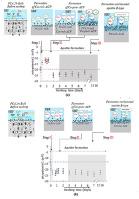Journal of Physics and Chemistry of Solids ( IF 4.3 ) Pub Date : 2021-04-29 , DOI: 10.1016/j.jpcs.2021.110122 Atef Dridi , Khira Zlaoui Riahi , Saida Somrani

|
Calcium phosphate-based bioactive materials have recently attracted considerable attention. In particular, poorly crystalline apatites (PCA) are successfully used for bone repair and regeneration, enhancing the osteointegration and osteoconduction properties. Our study aims to better understand the mechanism of apatite formation on the poorly crystallized apatite powders. For this purpose, two PCA samples were synthesized in the same conditions while varying only the maturation time.
The most noticeable difference between both samples is that the immature specimen (PCA2h) was richer in both water and labile species than the mature specimen (PCA2m). Besides, it has a higher surface area and more negatively charged surface. Both PCA samples were soaked in a simulated body fluid (SBF) for different periods of time at 37 °C, leading to the neoformation of bone-like apatite layer on their surfaces due to their bioactivity. The surface of all samples was investigated using scanning electron microscopy (SEM) coupled with energy-dispersive X-ray (EDX) spectroscopy, zeta-potential measurements and BET analysis. FTIR spectroscopy, XRD, and TG-DTA were used to characterize bulk samples. Thermodynamic calculations of CaP precipitation were also performed. Experimental and theoretical data showed that the bone-like apatite formation mechanism on both samples undergoes by three stages. Only on the PCA2h, did a fast precipitation of positively Ca-rich amorphous phase (ACP) occur at a first time (prenucleation stage). It is converted into Ca-poor ACP by uptaking anions from surrounding media, to promote the formation of apatite nuclei during the second stage (nucleation stage). Then, nascent apatite crystals grew into bone like-apatite coating by poorly crystallized BCO3-apatite which is the most thermodynamically stable CaP phase in SBF (growing and maturation stage). While the bone like-apatite formation process on the mature PCA particles include similar events without Ca-rich ACP deposit. Thus, the formation of the Ca-poor ACP starts immediately at the beginning of soaking (at the 1st stage), followed by apatite nucleation (2nd stage), promoting the growth and maturation of BCO3-apatite crystals (3rd stage). Our results highlight the fact that in the waterlogged conditions of the hydrated shells surrounding the immature PCA nanocrystals, a high density of labile orthophosphate anions leads enriches the PCA-liquid solution interface in Ca2+ ions, momentarily stabilizing them into a positively charged amorphous complex likely to be strongly solvated. Then, this interface becomes more attractive for free orthophosphate anions, enhancing the bioactivity to improve osteointegration. The composition of the hydrated shells coating of the biomimetic apatite crystal in both labile species and hydration water seems to govern their bioactivity via surface charge potential and hydrophilic capacity. These data allow a better understanding of the bioactive behaviour of biomaterials involving biomimetic PCA phases for tissue engineering.
中文翻译:

在37°C的模拟体液(SBF)中结晶不良的磷酸钙上形成磷灰石的机理
基于磷酸钙的生物活性材料近来引起了相当大的关注。特别是,结晶度差的磷灰石(PCA)已成功用于骨骼修复和再生,从而增强了骨整合和骨传导性能。我们的研究旨在更好地了解结晶度差的磷灰石粉末上磷灰石形成的机理。为此,在相同条件下合成了两个PCA样品,但仅改变了成熟时间。
两种样品之间最明显的区别是,未成熟样品(PCA2h)的水分和水分含量均较高。 不稳定种比成熟标本(PCA2m)好。此外,它具有更大的表面积和更多带负电荷的表面。两种PCA样品均在37°C下浸泡在模拟体液(SBF)中不同的时间,由于它们的生物活性,导致在其表面形成骨状磷灰石层的新形成。使用扫描电子显微镜(SEM)结合能量色散X射线(EDX)光谱,ζ电位测量和BET分析研究了所有样品的表面。FTIR光谱,XRD和TG-DTA用于表征大批样品。还进行了CaP沉淀的热力学计算。实验和理论数据表明,两种样品的骨样磷灰石形成机理都经历了三个阶段。仅在PCA2h上,在第一次(预成核阶段)发生了正钙富集的非晶相(ACP)的快速沉淀。它通过吸收周围介质中的阴离子将其转化为贫Ca的ACP,以在第二阶段(成核阶段)促进磷灰石核的形成。然后,初生的磷灰石晶体由于BCO结晶不良而长成骨样磷灰石涂层3-磷灰石是SBF(生长和成熟阶段)中热力学最稳定的CaP相。虽然在成熟的PCA颗粒上形成骨样磷灰石的过程包括没有富Ca的ACP沉积的类似事件。因此,钙差ACP的形成在浸泡(在1个的开始立即开始第一阶段),接着磷灰石成核(第2阶段),促进BCO的生长和成熟3个-apatite晶体(第三阶段)。我们的结果凸显了这样一个事实,即在未成熟PCA纳米晶体周围水化壳的浸水条件下,高密度的不稳定正磷酸盐阴离子导致Ca 2+中PCA-溶液界面富集。离子,将它们暂时稳定为带正电的非晶态复合物,可能会强烈溶解。然后,该界面对游离正磷酸盐阴离子变得更具吸引力,从而增强了生物活性,从而改善了骨整合。不稳定物种和水合水中仿生磷灰石晶体的水合壳涂层的组成似乎通过表面电荷势和亲水性来控制其生物活性。这些数据可以更好地了解涉及仿生PCA相用于组织工程的生物材料的生物活性行为。











































 京公网安备 11010802027423号
京公网安备 11010802027423号